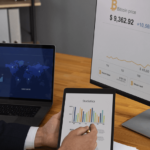As the role of the Chief Financial Officer (CFO) expands, having the right tools to navigate complex financial landscapes becomes crucial. A CFO dashboard is one such tool, providing a real-time, comprehensive view of a company’s financial and operational performance. This guide covers what a CFO dashboard is, its key features, essential metrics, and the strategic benefits it offers.
Table of Contents
What is a CFO Dashboard?

A CFO dashboard is an interactive tool that consolidates key financial data, providing CFOs with an easy-to-access platform for monitoring the health of their organization. This dashboard presents critical metrics like cash flow, revenue, expenses, and profitability in a visual format, allowing for quick and informed decision-making. In essence, a CFO dashboard is the command centre for managing a company’s financial strategy and operations.
Key Features of a CFO Dashboard

1. Real-Time Data Integration:
CFO dashboards integrate data from various systems such as Enterprise Resource Planning (ERP), accounting software, and Customer Relationship Management (CRM) platforms. This integration ensures that the dashboard always displays the most current data, enabling CFOs to make decisions based on the latest financial information.
2. Customizable Key Performance Indicators (KPIs):
Different businesses prioritize different financial indicators. A CFO dashboard allows users to customize the KPIs according to the business’s specific needs. Some commonly tracked KPIs include:
- Quick Ratio: Measures a company’s ability to meet short-term obligations with its most liquid assets.
- Current Ratio: Assesses a company’s ability to pay off short-term liabilities with its short-term assets.
- Operating Cash Flow: Tracks the cash generated by a company’s core business operations.
- EBITDA: Evaluates a company’s profitability before interest, taxes, depreciation etc
3. User-Friendly Visualizations:
- Data visualization is a key feature of CFO dashboards. By presenting data through charts, graphs, and tables, dashboards make complex information easier to understand briefly. This helps CFOs quickly spot trends, identify issues, and act.
4. Drill-Down Capabilities:
- CFO dashboards often allow users to dive deeper into data points for detailed analysis. This feature is essential for understanding the causes behind high-level metrics, such as exploring why a drop in gross margin occurred
5. Forecasting and Scenario Analysis:
- Beyond historical and real-time data, CFO dashboards often include tools for forecasting future performance under various scenarios. This allows CFOs to prepare for different outcomes, such as changes in market conditions or internal financial strategies
6. Collaboration and Reporting:
- CFO dashboards typically offer collaboration features, allowing CFOs to share insights and reports easily with other executives or board members. This promotes alignment and ensures that all stakeholders are informed and engaged in the decision-making process .
Essential Metrics for a CFO Dashboard

Selecting the right metrics is crucial to making the CFO dashboard an effective tool. Here are some of the most important metrics that should be tracked:
7. Working Capital:
Working capital is the difference between a company’s current assets and current liabilities. It measures a company’s efficiency and its short-term financial health. Monitoring working capital helps ensure that the company has enough liquidity to sustain operations and invest in growth opportunities.
8. Gross Profit Margin:
Gross profit margin shows the percentage of revenue remaining after subtracting the cost of goods sold (COGS). It is a critical measure of a company’s pricing strategy and production efficiency. A declining gross margin could indicate rising costs or pricing pressures that need to be addressed .
9. Operating Cash Flow:
This metric tracks the cash generated from a company’s core business activities. It’s a key indicator of the company’s financial health, distinct from its investment or financing activities. Positive operating cash flow is crucial for maintaining and expanding the business .
10. Net Burn Rate and Cash Runway:
For startups and rapidly growing companies, tracking how quickly cash reserves are depleting (net burn rate) and how long the company can continue operating without additional funding (cash runway) is vital. These metrics help CFOs manage cash flow and make informed decisions about fundraising .
11. Return on Equity (ROE):
ROE measures how effectively a company is using shareholders’ equity to generate profits. It’s a critical indicator for investors and provides insights into the efficiency of a company’s use of equity. Higher ROE values typically indicate more efficient use of equity to generate profits .
12. Customer Acquisition Cost (CAC) and Lifetime Value (CLV):
CAC tracks the cost of acquiring a new customer, while CLV estimates the total revenue a company can expect from a customer over the relationship. Balancing CAC and CLV is essential for maintaining profitability, especially in subscription-based or high-churn businesses
13. Debt-to-Equity Ratio:
This ratio compares a company’s total liabilities to its shareholders’ equity, providing insight into its financial leverage. A high debt-to-equity ratio may suggest that a company is heavily reliant on debt to finance its growth, which can be risky during economic downturns .
14. Accounts Payable Turnover:
This metric measures how quickly a company pays off its suppliers. A lower turnover ratio might indicate cash flow problems, while a higher ratio can suggest better management of payables .
Strategic Benefits of a CFO Dashboard

15. Improved Decision-Making:
CFO dashboards consolidate critical financial data into one platform, enabling CFOs to make decisions quickly and based on the most accurate and up-to-date information. This capability is crucial for responding effectively to both challenges and opportunities as they arise
16. Enhanced Financial Monitoring:
With a comprehensive overview of the company’s financial health, CFO dashboards help identify potential risks before they become significant problems. Monitoring metrics like working capital, operating cash flow, and debt levels can prevent financial crises and ensure long-term stability .
17. Increased Transparency and Accountability:
CFO dashboards promote transparency by making it easier to track and report financial performance. This not only helps in internal decision-making but also builds trust with external stakeholders like investors and board members, who rely on accurate and timely financial data
18. Strategic Planning and Forecasting:
CFO dashboards are invaluable for strategic planning. They allow CFOs to forecast future performance, model different scenarios, and make data-driven decisions about resource allocation, risk management, and growth strategies
19. Proactive Risk Management:
Real-time data access enables CFOs to identify and mitigate financial risks early. For example, by tracking the debt-to-equity ratio and accounts payable turnover, CFOs can detect potential financial stress before it impacts the business .
20. Alignment with Business Goals:
CFO dashboards help ensure that financial metrics are aligned with broader business goals. This alignment fosters better coordination across departments and drives overall organizational performance
Conclusion
CFO dashboards are more than just financial reporting tools—they are strategic assets that empower CFOs to lead their organizations with precision. While providing a real-time, holistic view of financial and operational data, these dashboards enable CFOs to make better decisions, manage risks, and drive sustainable growth. Whether you’re leading a startup or managing a large enterprise, investing in a comprehensive CFO dashboard is crucial for achieving your financial and strategic objectives.
As the role of the CFO continues to evolve, having access to the right tools will be essential for staying competitive and ensuring long-term success. A well-designed CFO dashboard is not just a tool for tracking numbers—it’s a gateway to smarter, more strategic decision-making that can propel your company forward.












